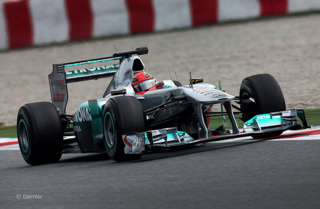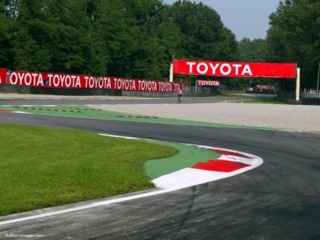The Unofficial Alt+F1 Beginner's Guide to Formula 1! — Technical Jargon
By aurahack 3 Comments

There’s a lot of really technical shit in F1 that’s worth explaining quick, so I’ll go over the most commonly used terms and what they mean.
KERS/ERS-K
KERS, a system introduced into the sport a few years ago, will see changes this year as well. KERS, which stands for Kinetic Energy Recovery System, is a device separate to the car’s engine that would store kinetic energy released from braking into a “battery”, which could then be re-used as a boost during a race. Each lap, the driver would be allotted a set amount of “energy” to use during a lap, with the allotted amount resetting back to full on a new lap.
As of 2014 season, KERS is being renamed to ERS-K, and is seeing a change in its design. It is now integrated into the engine itself and will also capture heat dispelled from the turbochargers in the engine, which can then be re-used as a boost similar to the former KERS setup.
The biggest change comes to its use, however. Formerly, KERS could only be used for a total of six seconds during a lap and would output an extra 80 hp. This year, it will output 161 extra hp and can be used for a total of 33 seconds per lap. This is close to a third of a lap on most tracks, (with more than a third on shorter tracks) so ERS-K will see far more use in this year’s season than in previous seasons.
DRS

DRS stands for Drag Reduction System and is the mechanism that allows a “flap” on the rear wing to open. This reduces wind resistance and increases the car’s top speed at the expense of downforce. (Which keeps the car on track.) It was introduced as an incentive to overtake opponents and is primarily used as such.
DRS is only allowed in certain sections of the track referred to as DRS-enabled zones. For DRS to be enabled, they must be within one second of the driver ahead of them as they enter the DRS zone. DRS zones are typically straight sections of the track, since the reduced wind resistance makes navigating corners significantly more difficult. Regulations used to allow only one DRS zone per track, though 2013 saw this increase to two per track. Some tracks, such as Monaco, don’t have enough straight lines to allow two DRS zones, so they remained with one.
DRS used to also be allowed during any part of the track in qualifying, a rule that has been changed since 2013. Cars must now use DRS in DRS-only zones, even in qualifying.
DRS has seen its fair share of criticisms, with some blaming the system for making drivers rely too heavily on it when attempting to overtake.
Kerbs

Kerbs are the raised red and white sections that edge out corners on a circuit. They are indicators of a corner’s apex and exits, in addition to preventing drivers from cutting corners. Instead of driving on grass to cut a corner as close as possible, they instead driver over kerbs to maintain their grip and speed through a corner.
They are generally avoided in wet conditions, however, since the rain makes the kerbs’ surfaces quite slippery.
Paddock
Paddock is a general term used for the pit lane and the teams and media within it. When someone says “I heard rumors around the paddock…” they are simply saying “I heard it from someone who either works for a team or is involved with the race in some way.”
Tyre
A stupid English way of saying “tire”.
Tire Compounds
There are several tire compounds that serve several purposes, which can be broken down as such:
| Name | Color | Grip Level | Durability | Use |
|---|---|---|---|---|
| Super-soft (Option) | Red | Very High | Very Low | Used in rare occasions, especially in qualifying as to get the best time possible. |
| Soft (Option) | Yellow | High | Low | One of the most commonly used compounds. Used early/late in pit strategies. |
| Medium (Prime) | White | Medium | Medium | Common compound, used frequently. More suited to colder conditions. |
| Hard (Prime) | Orange | Low | High | Common compound, used frequently. More suited to warmer conditions. |
| Intermediate | Green | — | — | Used in wet conditions, generally when there is little presence of water on the track. |
| Wet | Blue | — | — | Used in wet conditions, only when there is heavy presence of water on the track. |
Before the start of a race weekend, Pirelli selects two types of tires to use out of its available four normal tires. One Soft tire (Option) and one Hard tire. (Prime) Teams are obligated to race on both sets of tires during a race, forcing at least one pit stop.
Though most races will see 2-3 pit stops, there are certain circuits that allow teams to push for 1-stop strategies at the expense of grip and durability.
Chicane
A quick succession of short swerving corners. Generally shaped like an S and used to reduce speeds in high-speed sections of a track.
Downforce
Used to refer to wind resistance pushing the car down onto the ground, increasing grip. The more downforce there is, the more the car sticks to the track at high speeds. In Formula 1, downforce is essential since cars frequently take turns well over 100mph.
Box
During a race, you will often hear pit crew and drivers alike use the term "box". This refers to the pit box, which is a team's garage in the pit lane. When a radio message is sent to the driver saying "Box this lap", (or more commonly "Box box box") it means the team is asking the driver to make a pit stop during their current lap.
FIA
FIA stands for Fédération Internationale de l'Automobile (International Automotive Federation) and is the governing body of Formula 1 regulations, as well as several other motorsports. The FIA oversees technical, team, driver, and track regulations as well enforcing rules set in place by them. You'll hear the FIA come up during a race if a post-race investigation has to take place. An in-race incident or regulation infraction will result in the FIA investigating the matter and, if they find the accused to be guilty, will issue a fine and/or other penalties.
FOM
FOM stands for Formula One Management and oversees the commercial operation of the sport. FOM operates everything related to the sport's broadcast, in addition to the sport's organization and sponsorships. FOM has complete control of its televised broadcast, using its own feed that it distributes to third-party broadcasters. FOM has seen criticism for this, particularly due to their iron grip over internet distribution of their content. The owner of FOM, Bernie Ecclestone, has also seen criticism for legal and monetary deals that have taken place in favor of profit over the sport's benefit. (See: the Bahrain 2013-2013 incidents.)
~
